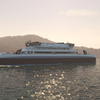Crowley Maritime Corporation christened the first of six new 185,000-barrel Articulated Tug-Barge (ATB) tank vessels that the company will take delivery of over the next two and half years. The vessels christened were the 9,280 HP-tug Pacific Reliance and barge 650-1.
At ceremonies held at the Mobile Convention Center on South Water Street, Constance Crowley Peabody, aunt of Tom Crowley Jr., company chairman, president and CEO, christened the Pacific Reliance, while Janet Bishop from ConocoPhillips, christened barge 650-1.
Crowley's Petroleum Services group will charter the VT Halter Marine-built ATB from Crowley's vessel construction and naval architecture subsidiary, Vessel Management Services, and operate it for ConocoPhillips under a three-year agreement. Crowley already has four, 155,000-barrel ATBs operating on the U.S. West Coast.
"We are thrilled to be expanding our ATB fleet with these new, larger, state-of-the-art vessels," said Crowley. "Our existing ATBs have performed extremely well for our petroleum customers and we're confident that this new ATB will provide ConocoPhillips with many years of safe, reliable and efficient transportation for their products."
An ATB has an articulated, or hinged, connection system between the tug and barge, which allows movement in one axis, or plane in the critical area of fore and aft pitch.
Crowley and VT Halter Marine jointly designed the ATB tank vessel. The barge 650-1 was built at Halter's shipyard in Pascagoula, Miss., and the Pacific Reliance at its shipyard, in Moss Point, Miss.
Boyd E. King, VT Halter Marine's CEO said "VT Halter Marine's order book is growing thanks to multi-year projects like Crowley's six-unit ATB order. This project highlights VT Halter Marine's ability to utilize the joint capabilities of its specialized facilities that work in concert to produce a diverse product line of commercial and defense related vessels."
The new ATBs feature the latest systems technology and double-hull construction for maximum safety and reliability. Not only does the unit have the capability of transporting refined products, but it can also carry heated cargoes and easy chemicals, which require special arrangements of vents, stripping systems, pump components and tank coatings above that normally required for product carriers.
All of Crowley's ATBs are built under the ABS SafeHull program for environmental protection. This program puts the vessel design through an exhaustive review to identify structural loads and strengthen the vessel structure. The 650-Class barges will be 27,000 deadweight tons, 587 feet in length, 74 feet in breadth and 40 feet in depth. The fully loaded draft will be 30 feet.
There is an electric cargo pump in each of the 14 cargo tanks to assure maximum cargo integrity and segregation flexibility; two anchor windlasses and associated equipment to enable the vessel to accommodate offshore mooring operations; and a vacuum system with three retention tanks to easily handle cargo changes. There is also a dual mode inert gas system and vapor collection system for maximum safety. A layer of inert gas covers products in the tanks to make the atmosphere too lean for combustion. An enhanced mooring system features 1,000-foot Spectra-type lines on split drums with a high-speed recovery rate of 100 feet per minute.
The tugs meet all SOLAS (Safety of Life at Sea) and ABS criteria, and have a foam capable fire monitor; twin fuel-efficient diesel engines; a noise reduction package; and other upgrades to increase crew comfort. The communication and navigation equipment is among the most technologically advanced in the industry today.
These six new ATBs will join a fleet of four, 155,000-barrel Crowley ATBs already in service. The Sea Reliance/550-1, Sound Reliance/550-2, Ocean Reliance /550-3 and Coastal Reliance/550-4 have each made over 100 successful voyages. The ATB fleet has moved over 65 million barrels of product with zero spills and only two Lost Time Incidents (LTI) in three and a half years, averaging approximately 20 million barrels moved a year.
Subscribe for
Maritime Reporter E-News
Maritime Reporter E-News is the maritime industry's largest circulation and most authoritative ENews Service, delivered to your Email five times per week










